Abstract
Triphenylsulphonium ions inhibit mitochondrial oxidative phosphorylation and adenosine triphosphatase activity. The site of action is on the soluble F1 adenosine triphosphatase component. Triphenylsylphonium ions also inhibit electron transfer in the NAD-cytochrome b region of the respiratory chain. In both types of inhibition, triphenylsulphonium ions are effective at low concentrations, half-maximal inhibition being produced by a concentration of about 20-30 muM. These effects resemble the effects of alkylguanidines on mitochondria and are discussed in relation to the effects of alkylguanidines and other lipophilic cations such as ethidium and dibenzyldimethylammonium ions. A modification of the purification procedure for the soluble mitochondrial adenosine triphosphatase [Beechey, Hubbard, Linnett, Mitchell & Munn (1975) Biochem. J. 148, 533-537] IS DESCRIBED, WHICH YIELDS A PREPARATION WITH A HIGHER SPECIFIC ACTIVITY AND SHOWING FEWER BANDS IN GEL ELECTROPHORESIS.
Full text
PDF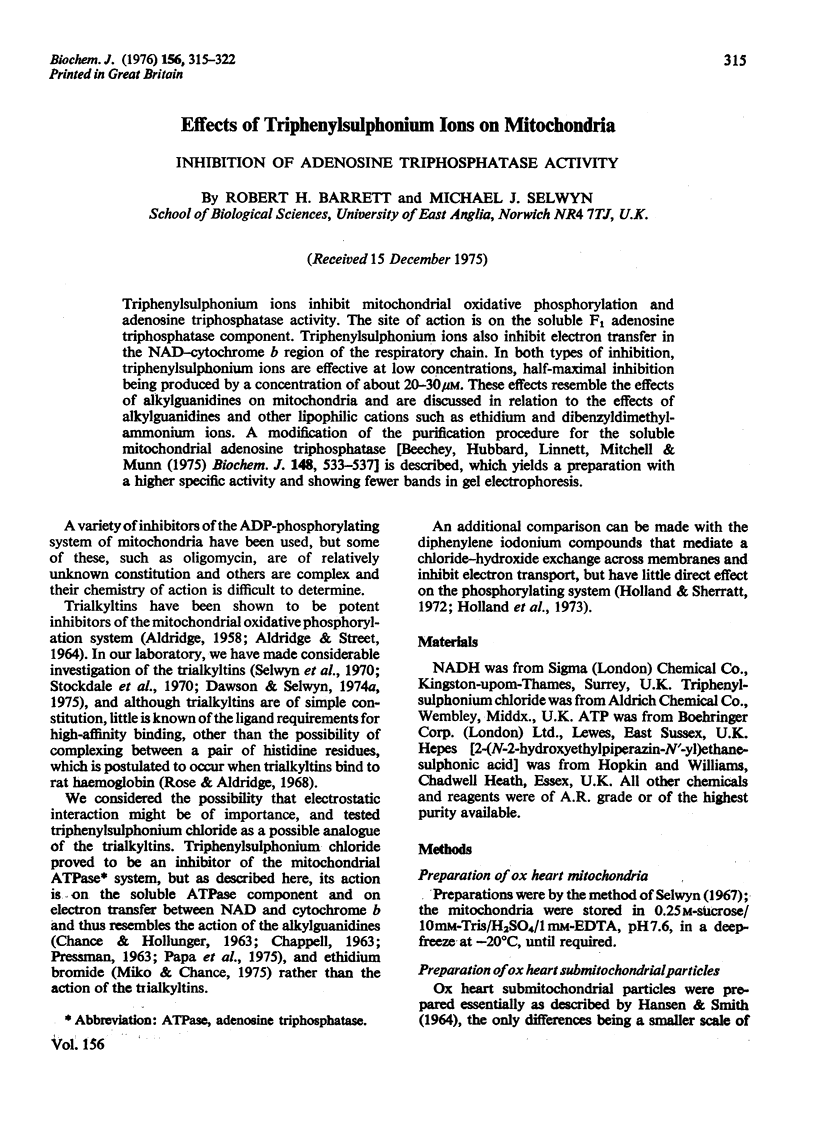
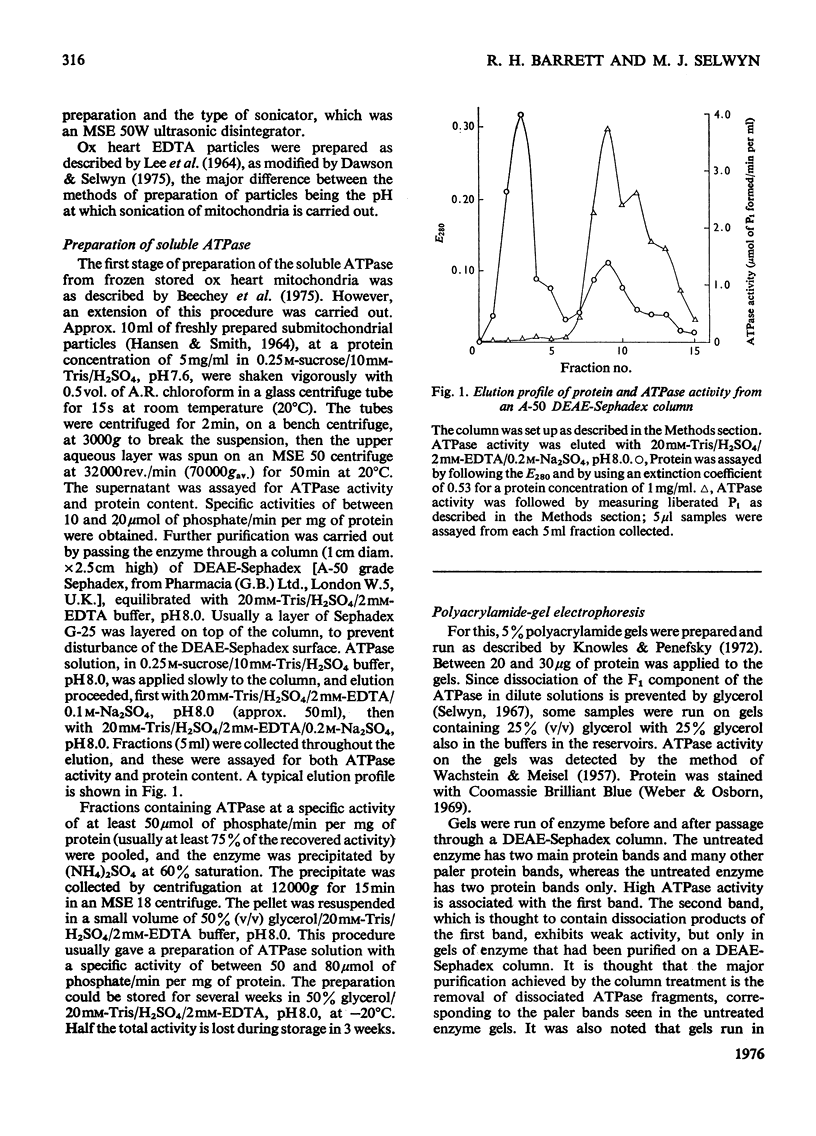
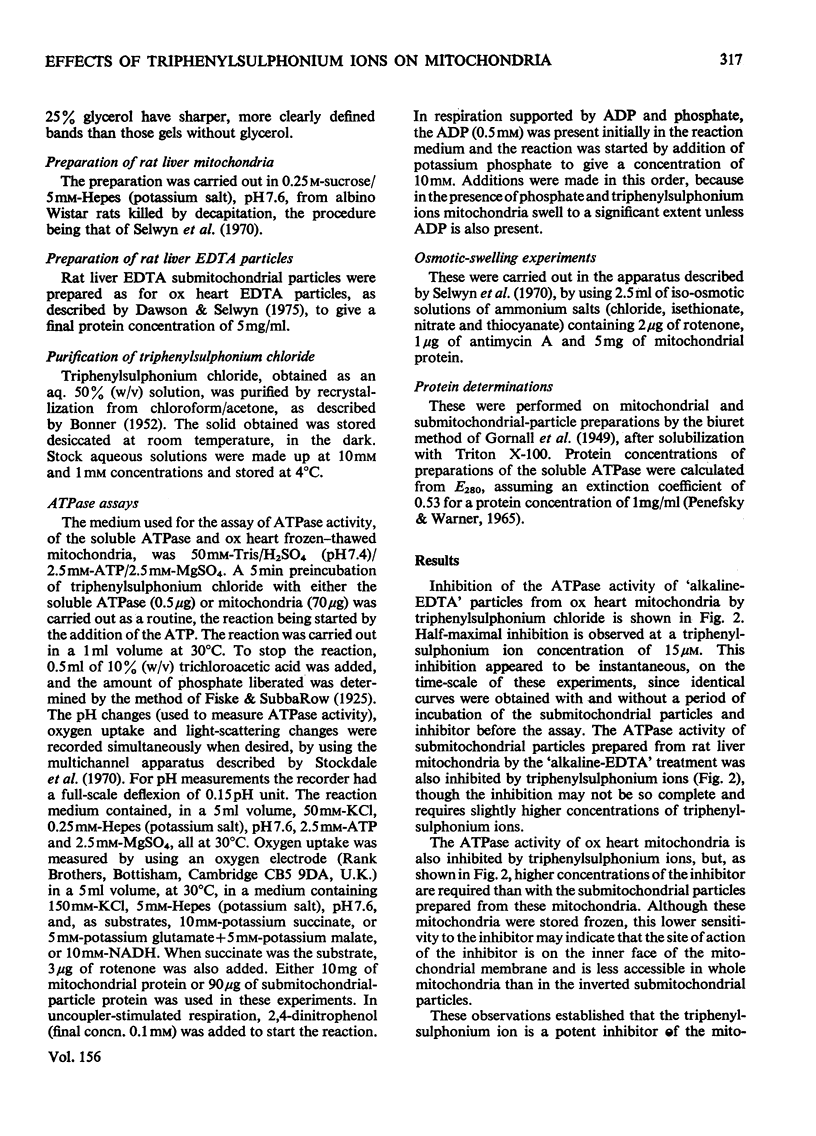
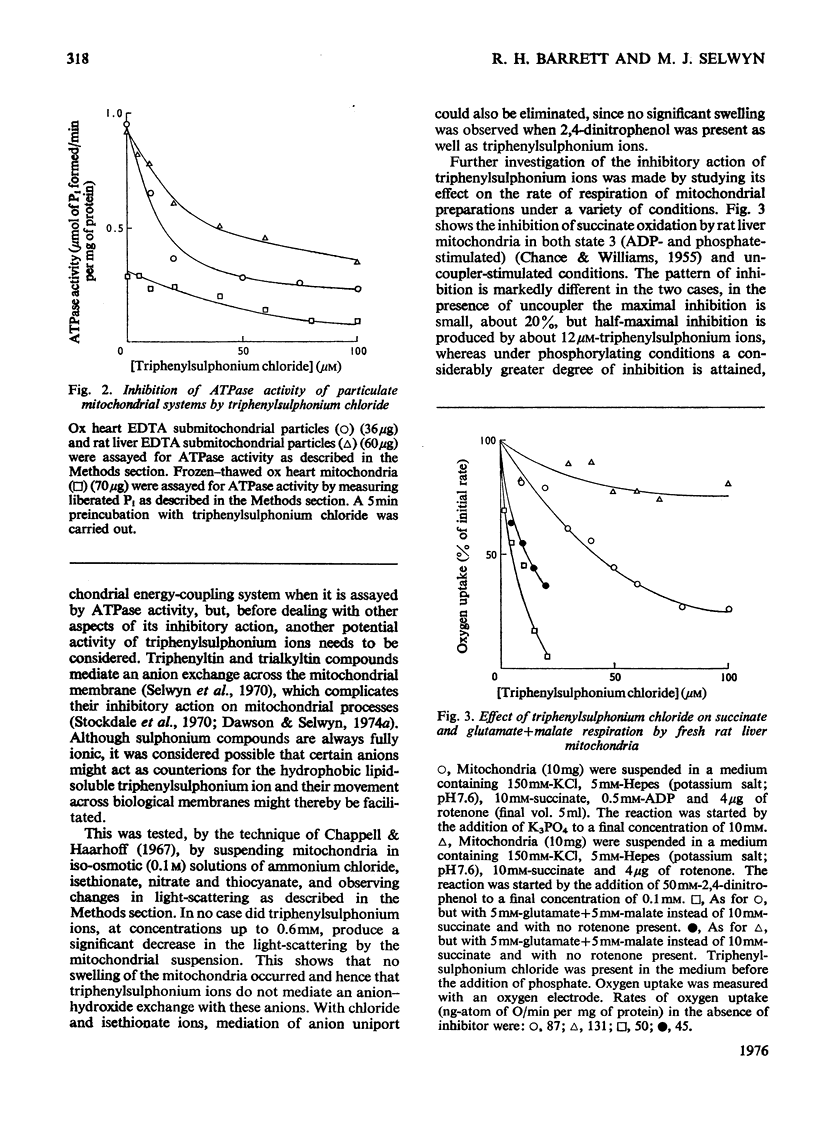

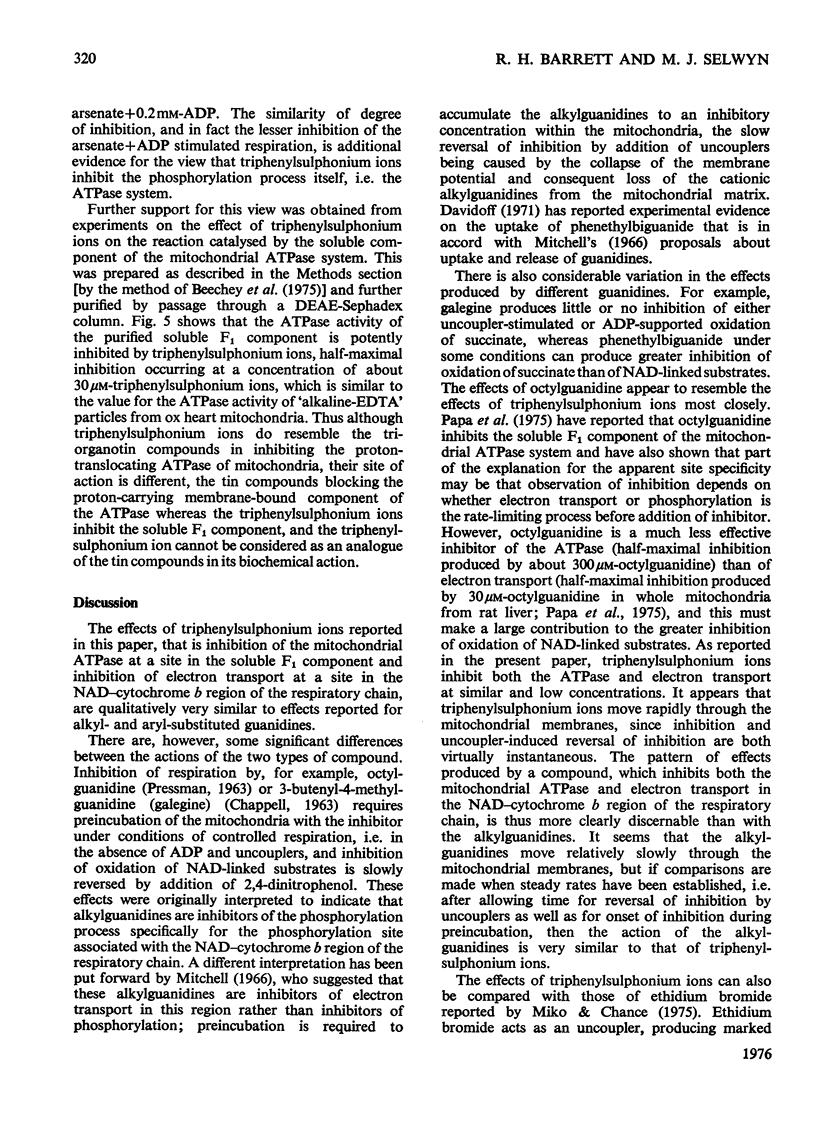
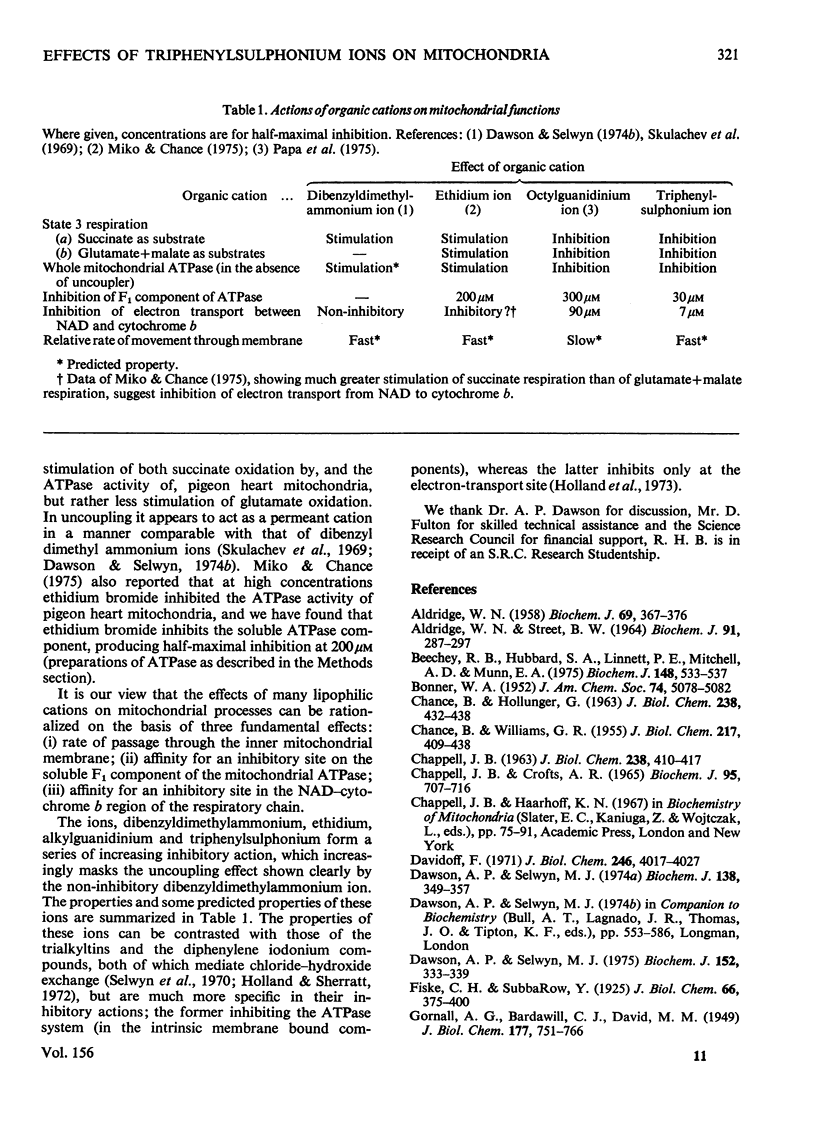
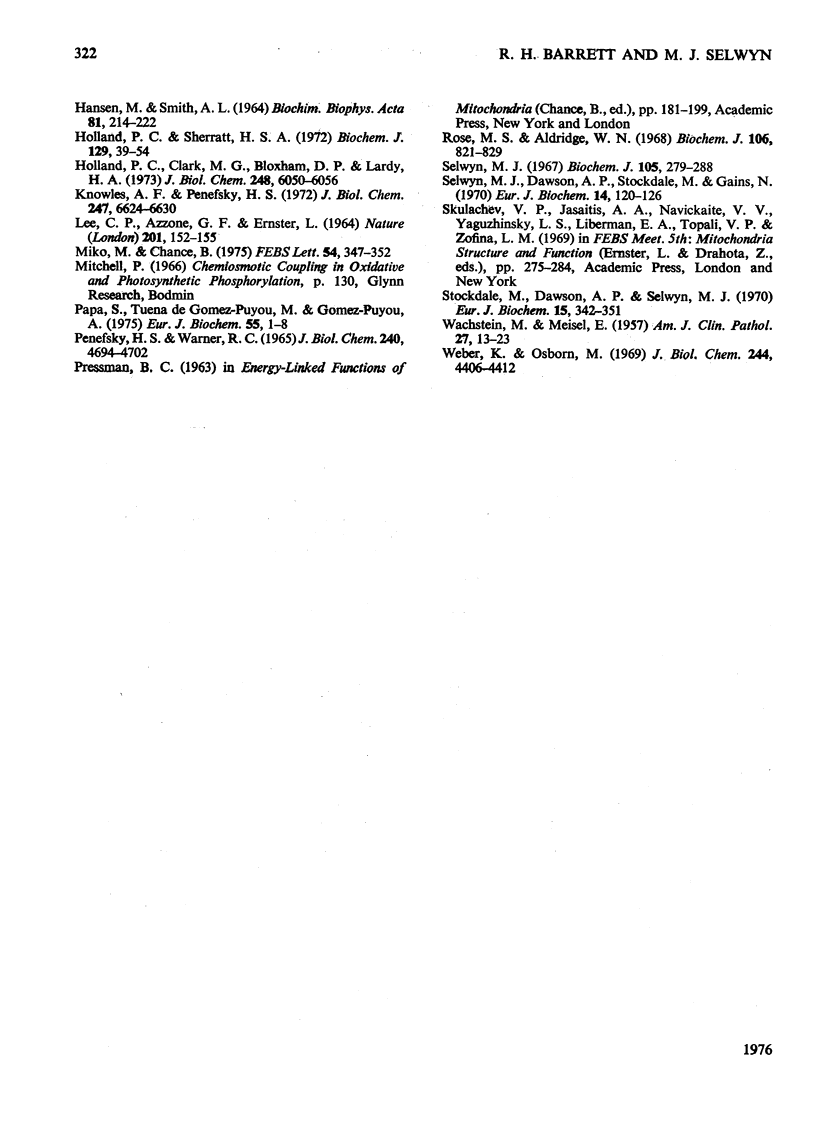
Selected References
These references are in PubMed. This may not be the complete list of references from this article.
- ALDRIDGE W. N. The biochemistry of organotin compounds: trialkyltins and oxidative phosphorylation. Biochem J. 1958 Jul;69(3):367–376. doi: 10.1042/bj0690367. [DOI] [PMC free article] [PubMed] [Google Scholar]
- Aldridge W. N., Street B. W. Oxidative phosphorylation. Biochemical effects and properties of trialkyltins. Biochem J. 1964 May;91(2):287–297. doi: 10.1042/bj0910287. [DOI] [PMC free article] [PubMed] [Google Scholar]
- Beechey R. B., Hubbard S. A., Linnett P. E., Mitchell A. D., Munn E. A. A simple and rapid method for the preparation of adenosine triphosphatase from submitochondrial particles. Biochem J. 1975 Jun;148(3):533–537. doi: 10.1042/bj1480533. [DOI] [PMC free article] [PubMed] [Google Scholar]
- CHANCE B., HOLLUNGER G. Inhibition of electron and energy transfer in mitochondria. II. The site and the mechanism of guanidine action. J Biol Chem. 1963 Jan;238:432–438. [PubMed] [Google Scholar]
- CHANCE B., WILLIAMS G. R. Respiratory enzymes in oxidative phosphorylation. IV. The respiratory chain. J Biol Chem. 1955 Nov;217(1):429–438. [PubMed] [Google Scholar]
- CHAPPELL J. B., CROFTS A. R. THE EFFECT OF ATRACTYLATE AND OLIGOMYCIN ON THE BEHAVIOUR OF MITOCHONDRIA TOWARDS ADENINE NUCLEOTIDES. Biochem J. 1965 Jun;95:707–716. doi: 10.1042/bj0950707. [DOI] [PMC free article] [PubMed] [Google Scholar]
- CHAPPELL J. B. The effect of alkylguanidines on mitochondrial metabolism. J Biol Chem. 1963 Jan;238:410–417. [PubMed] [Google Scholar]
- Davidoff F. Effects of guanidine derivatives on mitochondrial function. 3. The mechanism of phenethylbiguanide accumulation and its relationship to in vitro respiratory inhibition. J Biol Chem. 1971 Jun 25;246(12):4017–4027. [PubMed] [Google Scholar]
- Dawson A. P., Selwyn M. J. The action of trialkyltin compounds on mitochondrial respiration. The effect of pH. Biochem J. 1974 Mar;138(3):349–357. doi: 10.1042/bj1380349. [DOI] [PMC free article] [PubMed] [Google Scholar]
- Dawson A. P., Selwyn M. J. The action of tributyltin on energy coupling in coupling-factor-deficient submitochondrial particles. Biochem J. 1975 Nov;152(2):333–339. doi: 10.1042/bj1520333. [DOI] [PMC free article] [PubMed] [Google Scholar]
- Holland P. C., Clark M. G., Bloxham D. P., Lardy H. A. Mechanism of action of the hypoglycemic agent diphenyleneiodonium. J Biol Chem. 1973 Sep 10;248(17):6050–6056. [PubMed] [Google Scholar]
- Holland P. C., Sherratt H. S. Biochemical effects of the hypoglycaemic compound diphenyleneiodonnium. Catalysis of anion-hydroxyl ion exchange across the inner membrane of rat liver mitochondria and effects on oxygen uptake. Biochem J. 1972 Aug;129(1):39–54. doi: 10.1042/bj1290039. [DOI] [PMC free article] [PubMed] [Google Scholar]
- Knowles A. F., Penefsky H. S. The subunit structure of beef heart mitochondrial adenosine triphosphatase. Physical and chemical properties of isolated subunits. J Biol Chem. 1972 Oct 25;247(20):6624–6630. [PubMed] [Google Scholar]
- LEE C. P., AZZONE G. F., ERNSTER L. EVIDENCE FOR ENERGY-COUPLING IN NON-PHOSPHORYLATING ELECTRON TRANSPORT PARTICLES FROM BEEF-HEART MITOCHONDRIA. Nature. 1964 Jan 11;201:152–155. doi: 10.1038/201152a0. [DOI] [PubMed] [Google Scholar]
- Miko M., Chance B. Ethidium bromide as an uncoupler of oxidative phosphorylation. FEBS Lett. 1975 Jul 1;54(3):347–352. doi: 10.1016/0014-5793(75)80937-9. [DOI] [PubMed] [Google Scholar]
- Penefsky H. S., Warner R. C. Partial resolution of the enzymes catalyzing oxidative phosphorylation. VI. Studies on the mechanism of cold inactivation of mitochondrial adenosine triphosphatase. J Biol Chem. 1965 Dec;240(12):4694–4702. [PubMed] [Google Scholar]
- Rose M. S., Aldridge W. N. The interaction of triethyltin with components of animal tissues. Biochem J. 1968 Feb;106(4):821–828. doi: 10.1042/bj1060821. [DOI] [PMC free article] [PubMed] [Google Scholar]
- Selwyn M. J., Dawson A. P., Stockdale M., Gains N. Chloride-hydroxide exchange across mitochondrial, erythrocyte and artificial lipid membranes mediated by trialkyl- and triphenyltin compounds. Eur J Biochem. 1970 May 1;14(1):120–126. doi: 10.1111/j.1432-1033.1970.tb00268.x. [DOI] [PubMed] [Google Scholar]
- Selwyn M. J. Preparation and general properties of a soluble adenosine triphosphatase from mitochondria. Biochem J. 1967 Oct;105(1):279–288. doi: 10.1042/bj1050279. [DOI] [PMC free article] [PubMed] [Google Scholar]
- Stockdale M., Dawson A. P., Selwyn M. J. Effects of trialkyltin and triphenyltin compounds on mitochondrial respiration. Eur J Biochem. 1970 Aug;15(2):342–351. doi: 10.1111/j.1432-1033.1970.tb01013.x. [DOI] [PubMed] [Google Scholar]
- WACHSTEIN M., MEISEL E. Histochemistry of hepatic phosphatases of a physiologic pH; with special reference to the demonstration of bile canaliculi. Am J Clin Pathol. 1957 Jan;27(1):13–23. doi: 10.1093/ajcp/27.1.13. [DOI] [PubMed] [Google Scholar]
- Weber K., Osborn M. The reliability of molecular weight determinations by dodecyl sulfate-polyacrylamide gel electrophoresis. J Biol Chem. 1969 Aug 25;244(16):4406–4412. [PubMed] [Google Scholar]


